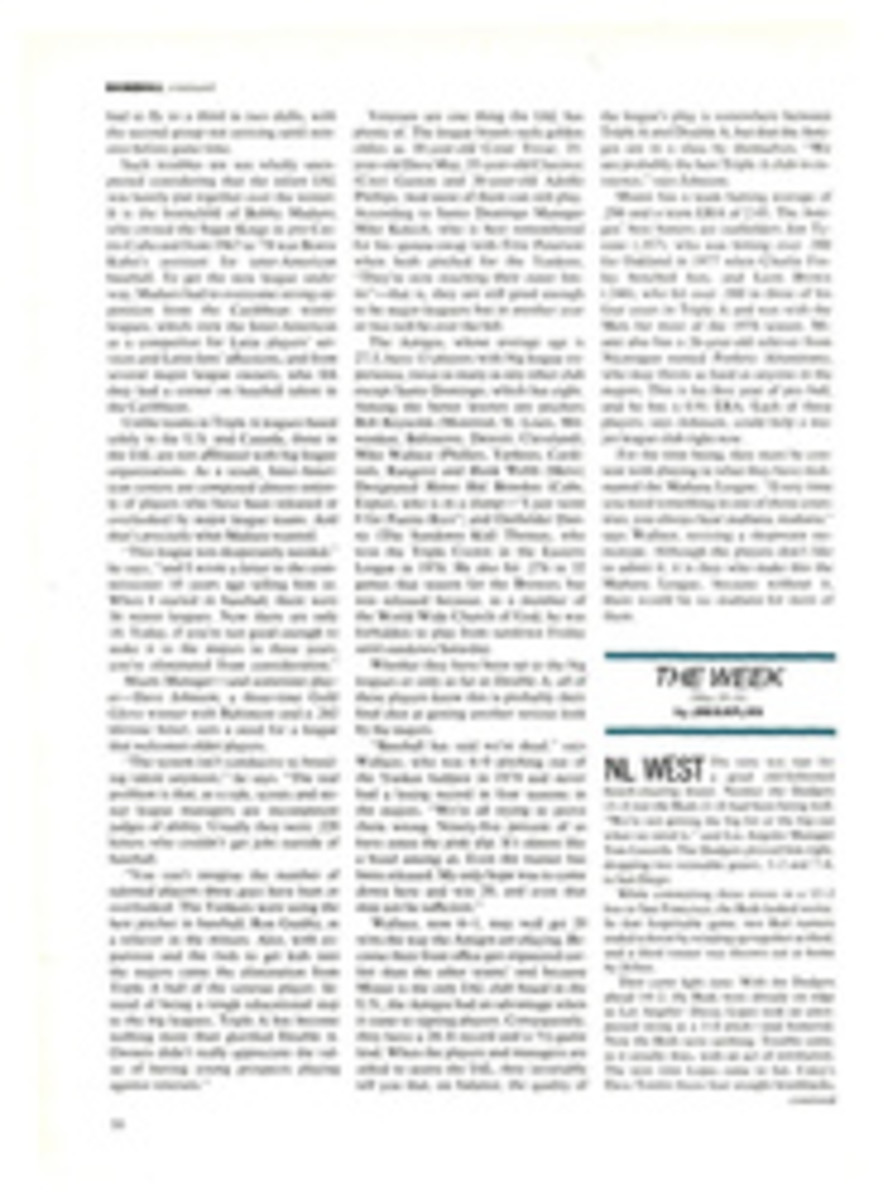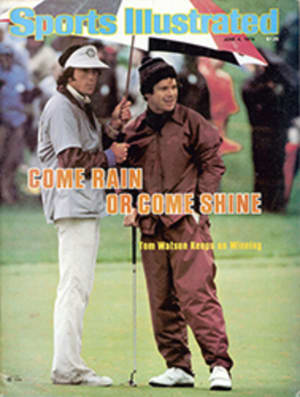
NOBODY DOES IT BETTER THAN THEY DO
The only thing more impressive than the play of Johns Hopkins in last Saturday's NCAA lacrosse championship was the acclaim that followed it. At the University of Maryland's Byrd Stadium the Blue Jays not only beat the Terrapins in the fine points of the game but outhustled and outmuscled them as well. When the 15-9 mauling was all over, the Maryland players gathered at midfield and paid tribute to their archrivals with a cheer, but the ultimate praise came from the Hopkins coach, Henry (Chic) Ciccarone. In an almost empty locker room an hour after the game, he summed up his team's effort by saying, "I think you have to call this the greatest Johns Hopkins lacrosse team ever."
The greatest Johns Hopkins lacrosse team ever? It might be easier to name the most beautiful Miss America. Hopkins is synonymous with lacrosse excellence. Saturday's win gave the Blue Jays their second straight national championship but not their second overall, nor their fifth, nor 10th, nor even 20th. No, this was their 35th national title. Nevertheless, Ciccarone had logic to back up his boast.
"It's much harder to win the national championship now than it was a few years ago," he said. "There are so many more good players coming out of organized programs and so many more schools actively recruiting them that the competition has gotten much tougher. Yet, against the toughest schedule possible, this team went undefeated."
Ciccarone methodically ticked off the highlights of Hopkins' 13-0 season. The Blue Jays beat second-ranked Maryland and fifth-ranked Virginia twice each, while also defeating third-ranked Navy, fourth-ranked Cornell, and North Carolina State and Army, which finished tied for No. 6. "Despite that schedule, the defense allowed fewer than seven goals a game," Ciccarone said. "That's unheard of in today's faster, higher-scoring lacrosse." Ciccarone didn't bother to add that the Hopkins offense more than doubled its opponents' goal output and that his team's average margin of victory was more than eight goals. In the context of this season, Saturday's six-goal shellacking of Maryland was a squeaker.
But when the season began 10 weeks ago, the '79 Blue Jays seemed destined to live in the shadow of last year's squad. That team won its last six games before upsetting Cornell for the national championship. It didn't seem possible the Blue Jays could be that good again, since three first-team All-Americas, including Mike O'Neill, probably the finest attackman ever to play at Hopkins, had graduated. "At the start of the year all we heard about was last year's team and the players we had lost," says Midfielder Dave Huntley, one of Hopkins' co-captains. "Most of us were members of that team and played big roles in its success, so we didn't resent the mention of it. But at the same time we were anxious to establish an identity for this year's team."
The trademark that the '79 Blue Jays quickly established was an attack so evenly balanced that it made its individual members almost anonymous. Going into the title game, Maryland's top scorer, Attackman Bob Boneillo, had 74 points, 28 more than any other Terp. By contrast, the Blue Jays' leading scorer had only 33 points. But there were six Hopkins players with at least 27 points, and the overall balance was best indicated by the fact that the man with 33, Attackman Jim Zaffuto, was a second-stringer. "What made this team so good was that we never had to rely on one individual to do the job for us," Ciccarone says. "Whenever one player fell down, someone else picked up the slack."
Ciccarone is a superstitious sort who can find dire portent in the happiest of circumstances. Over the last three years Maryland would have been undefeated—had it not had to play Johns Hopkins. Not counting this year's championship, the Blue Jays had won five straight from the Terrapins, including semifinal victories in the NCAA tournament the past two seasons. Included in the streak was a 13-12 Blue Jay victory earlier this season. That record of prolonged success against Maryland would seem to have been ample reason for optimism last week, but not for Ciccarone. He couldn't help thinking back to last season's NCAA championship. Going into that game, defending champ Cornell had beaten Hopkins five in a row. "I just hope that wasn't an omen," Ciccarone said apprehensively.
Maryland Coach Bud Beardmore pinned his hopes for an upset on a new offense; he had moved his two top scorers, attackmen Boneillo and John Lamon, from their normal positions behind the cage to new spots in front of it. In the earlier Maryland-Hopkins game, Blue Jay defensemen had bottled up Boneillo and Lamon behind the goal. While they struggled to get free with the ball, the other Terrapins stood around and watched. Of Maryland's 12 goals that day, nine were unassisted. Beardmore hoped to get his offense moving by putting his two chief scoring threats where they had more room to maneuver.
He also planned to take advantage of the aggressiveness of the nation's best defenseman, Hopkins junior Mark Greenberg. Greenberg had covered Boneillo in the earlier game but had frequently slid off him to double-team someone else. When Greenberg's tactics let Boneillo get free behind the cage, it did Maryland little good. In front of the cage Boneillo would be in position to take a pass and shoot.
At first, Beardmore's strategy appeared to be working. Maryland took a 4-3 lead and might have opened up a wider margin had not Blue Jay Goalie Mike Federico made several extraordinary saves. Before long, however, the vaunted Hopkins defense came to Federico's aid.
Incredibly, for the first 11½ minutes of the second quarter the Blue Jays did not permit Maryland, perhaps the country's most offense-minded team, to get off a shot. Freshman Defenseman Dave Black rarely allowed Lamon to touch the ball, and Greenberg hounded Boneillo. Normally a defenseman won't follow an attackman out past the restraining line, which is located 60 feet in front of the cage, but Greenberg, unwilling to let Boneillo get a running start at the goal, stuck with him even when the Terrapin star retreated almost to midfield. What's more, he occasionally stripped the ball from Boneillo out there. Boneillo did get three goals and an assist, but two of the goals came on broken plays and the four points were well below his average.
Meanwhile, Hopkins scored five second-quarter goals to take an 8-4 half-time lead. The tying and go-ahead scores came on unassisted goals by Huntley, who, along with freshman Attackman Jeff Cook, had three goals. The 5-0 second quarter effectively sealed the outcome, though Maryland did close the gap to 8-6 early in the third period. The Blue Jays quickly retaliated with three goals of their own, and the Terrapins did not get within four thereafter.
Maryland's frustrations grew as the afternoon wore on. The Terrapins had an extra-man advantage for the final 30 seconds of the first half and failed to get a shot off. They repeatedly committed turnovers, throwing bad passes and dropping good ones. Maryland's low moment came with 7:17 remaining when Terrapin Defenseman Randy Ratliff tried to underhand the ball to back-up Goalie Rich Shassian and inadvertently flipped it into the goal for Hopkins' and the game's final score.
Afterward, Ciccarone credited much of his team's success to the leadership of his seniors, taking the occasion to point out that he was losing two of his top four defensemen—but not Black or Greenberg—and five of his seven best midfielders. Still, no one could imagine an end to the Hopkins winning streak, which now stands at 20. One of the best attackmen in the nation, Brendan Schneck, will be a junior at Hopkins next year. He sat out this season after transferring from Navy, where he was a first-team All-America as a sophomore in 1978. As for the shortage in the midfield, it is well known that the Blue Jays had a banner year in recruiting, including in their haul perhaps the best midfielder from the Baltimore area. His name? Henry A. Ciccarone Jr.
Over in the Maryland dressing room, Beardmore was being asked to look into the future. A reporter cited the Terrapins' six straight losses to Hopkins and the Blue Jays' incoming talent before asking, "How are you ever going to beat Hopkins?" For a moment Beardmore looked as if he might answer, but that moment gradually grew into a prolonged silence. At length he shook his head slowly. Then, in a voice just above a whisper, he answered, "I don't know."
PHOTO
JAMES DRAKE
Dave Huntley, the key man in Hopkins' balanced offense, pumped in three goals against the Terps.

